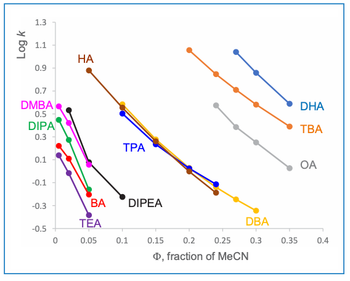Key Points
- Some liquid chromatography (LC) troubleshooting topics continue to remain relevant, even as technology evolves.
- In this edition of "LC Troubleshooting", Dwight Stoll discusses factors that can affect the peak widths of large molecules, especially for separations under gradient elution conditions.
- Large molecules depend on retention on mobile phase composition, which affects peak width and the sensitivity of separation quality to other factors.
Some LC troubleshooting topics never get old because there are some problems that persist in the practice of LC, even as instrument technology improves over time. There are many ways for things to go wrong in an LC system that ultimately manifest as peak widths that are wider than expected. Estimating the expected peak widths can help determine when a column and LC system are not working quite right and decide when troubleshooting should be initiated. When working with large molecules, there are more factors that can affect peak width that are not very relevant when working with small molecules. In this installment, I return to this topic and address peak widths for large molecules in more detail, particularly for separations under gradient elution conditions.
This installment of "LC Troubleshooting" is a continuation of a series I started in December of 2021 focused on the “essentials” of LC troubleshooting (1). The topics at the heart of this series are highly related to LCGC’s well-known “LC Troubleshooting” wall chart (2) that hangs in many laboratories. Topics covered already in the series include pressure problems (1), misbehaving retention times (3,4), peak shapes that don’t look right (5), strange baselines (6), sensitivity (7), and peak width (8). In Part VI, I discussed factors that dictate the peak widths we observe in chromatograms. Understanding these factors can help establish the basis of expectations for how wide peaks should be, so that when we see something that doesn’t fit those expectations, we know to pause and ask why. If there isn’t an obvious explanation, then we probably need to begin troubleshooting to identify the root cause of the (usually) wider-than-expected peaks, resolve that problem, and get back on track. However, in Part VI, I focused primarily on expectations for small molecules. When working with large molecules, there are several additional considerations we need to keep in mind that are either irrelevant, or much less important when working with small molecules. Understanding that there can be big diƒerences in the behavior of small and large molecules is a seemingly simple, but very important, piece of knowledge for the troubleshooting toolkit. Simply stated, most aspects of large molecule separations are more challenging and more prone to problems. Speaking for myself, as someone who “grew up” as a chromatographer primarily focused on small molecules, I have felt like I’ve had to relearn several aspects of both chromatographic theory and practice when my group started working more with large molecules about ten years ago. My aim with the following discussion is to provide some insights that may help readers who are newer to large molecule separations by easing their learning journey.
What is a "Large Molecule"?
I am not aware of a clear definition of the threshold beyond which we consider molecules “large” for chromatographic purposes, but in my mind, I think of the transition as somewhere in the neighborhood of 500 to 1,000 Da. Certainly a doubling of molecular weight from 100 to 200 Da has rather minor consequences in terms of the impact on diƒusion rates, peak broadening, and retention behavior. However, a doubling from 500 to 1,000 Da is a diƒerent story. Here, we start to see significant diƒerences in retention behavior, and a significant impact on peak broadening. So, for the purposes of discussion in this installment, anything larger than 1,000 Da is a “large molecule”, and anything smaller than 500 Da is a “small molecule.”
Review of the Basic Determinants of Peak Width
In Part VI, I discussed in some detail the theoretical relationships that dictate peak width in LC separations. Readers who have not already read Part VI should definitely read the “Essential Relationships” section of that installment because it also contains pointers to free LC simulation tools and some results obtained from those tools that support the discussion. However, given how critical these relationships are to understanding the behavior of both small and large molecules, I’m repeating a summary of the ideas here. The discussion assumes that we are working with reversed-phase liquid chromatography.
Isocratic Elution
We start by considering isocratic conditions—conditions where the mobile phase composition does not change during the analysis. In this case, in approximate terms, the more time the analyte spends in the column, the wider its peak is at the detector. One way of expressing this is shown in equation 1, where w is the 4∙σ width of the peak (drawn at about 13.4% of the peak height), N is the plate number (chromatographic efficiency), tm is the column dead time, and k is the isocratic retention factor of the analyte for a given mobile phase composition.
Estimating the column dead time is straightforward, and is nominally constant for a given column at a given flow rate. What is more interesting is to consider the effects of N and k on the width, and how these relate to the other parameters listed above (for example, analyte size). Estimating the plate number requires some knowledge about the extent to which peaks broaden when the flow rate changes. We start with what we refer to as the reduced form of the van Deemter equation, which relates the plate height to the mobile phase velocity (equation 2):
where ve is the reduced interstitial mobile phase velocity, and h is the reduced plate height. The important thing to recognize here is that this velocity is dependent on analyte size because the rate at which the analyte diffuses in the mobile phase affects the reduced velocity; generally speaking, at a given mobile phase flow rate, the reduced velocity increases with increasing molecular weight of the analyte. One of the advantages of using the reduced form of the van Deemter equation (equation 2) is that the coefficients A, B, and C are nominally independent of factors like particle size. In our work, we typically use values of 1.0, 5.0, and 0.05 for A, B, and C. Of course, these values are not truly constant, but they are good numbers to use to get an approximate value of the plate number under a given set of conditions. Readers interested in learning more about details related to these parameters are referred to a recent discussion of the topic (9). After calculating the reduced plate height, h, we can calculate the non-reduced plate height H, and finally, the plate number using equations 3 and 4, where dp is the particle size, and L is the column length.
Once the plate height (H) and plate number (N) have been estimated, the expected peak width can easily be calculated using equation 1 and estimates of the retention factor (k) and dead time (tm).
Gradient Elution
When working with gradient elution conditions, we have an expression for peak width that is similar to equation 1, with two important di‹erences. As shown in equation 5, we replace k with ke, and add the term G (G is the so-called gradient compression factor; it is not very important here, but interested readers should refer to Part VI of this series, and the references cited there for more discussion). We refer to ke as the local retention factor of the analyte in the mobile phase it experiences as it is exiting the column.
The value of ke is strongly affected by the gradient slope (b), which quantifies the rate of change of the mobile phase composition during the gradient. This relationship is shown in equation 6, where ∆ϕ is the change in the volume fraction of organic solvent in the mobile phase (0–1 scale for reversed-phase liquid chromatography [RP-LC]), and tg is the gradient time (note: b has no units!).
Generally speaking, larger gradient slopes lead to smaller ke values, and thus narrower peaks. The gradient slope increases with increases with and/or the dead time, and decreases as the gradient time is increased. However, the gradient slope is also strongly affected by the other parameter in equation 6, S, which is related to the sensitivity of the retention of a given analyte to the mobile phase composition. The simplest way to understand this parameter is that it is the negative of the slope of a plot of the natural logarithm of retention factor (ln[k]) of the analyte as a function of the mobile phase composition (0–1 scale). This particular relationship is an outcome of what has become known as linear solvent strength theory (LSST). If the value of S is known, then the value of ke is given by equation 7, where ki is the retention factor of the analyte in the mobile phase used at the starting point in the gradient elution program.
Interestingly, when td << tm, and b·ki >> 1, ke is approximately 1/b.
Implications of a Stronger Dependence on Solvent Composition
The fact that large molecules exhibit a stronger dependence of retention on mobile phase composition has been known for decades (10). When reviewing retention data for molecules covering a large range in molecular weight, Snyder and Dolan found that S can be estimated from the molecular weight (MW) using equation 8 (this assumes we are working with the natural logarithm of retention factor, as in Figure 1, and the MW is in Daltons):
Nevertheless, I think it is instructive to look at real data, and the implications that flow from this big diƒerence in behavior between small and large molecules. Figure 1 shows the dependence of retention factor (logarithmic scale) on mobile phase composition for three molecules of diƒerent size in the range of about 100 to 6000 Da. When these data are fit to a linear function of the mobile phase composition, as in LSST, the slopes are -7.49, -10.6, and -268 for the three molecules in order of increasing size. Using the slope and intercept from this plot, we can then calculate the local retention factor of the analyte as it travels from the inlet to the outlet of the column. As discussed above, the local retention factor of the analyte as it exits the column (ke) determines the peak width as dictated by equation 5. In this special case, the klocal at 50 mm from the inlet in Figure 2 is equal to the ke in equation 5. In Figure 2 we see a dramatic difference between the two smaller molecules and the 6 kDa biomolecule. For the two smaller molecules, we see that the local retention factor is about 2 when they exit the column, whereas the local retention factor of the larger molecule is near zero. Since the peak width dictated by equation 5 is proportional to the factor ke+1, this means that we would expect the peak for the biomolecule to be about one-third that of the smaller molecules, provided that the plate number for these three molecules is about the same (Note: this is an important caveat that must be assessed before making comparisons of experimental peak widths). On one hand, this difference in behavior is highly beneficial for separations of large molecules because it means that we have the potential to observe very narrow peaks under gradient elution conditions. On the other hand, however, this also means that these separations are prone to serious negative effects of extra-column dispersion that can make the peaks broader that can make the peaks broader than they should be–not because the column is not performing well, but because the narrow peaks exiting the column are compromised by broadening on the way to, and through, the detector. Readers unfamiliar with the details associated with these extra-column eƒects are referred to a series of recent articles in this magazine that focused on their origins, avoidance strategies, and a free tool that can be used to estimate their eƒects on real separations (11–14). A note of caution is warranted here. The ke values for large molecule depend very strongly on gradient slope. Thus, it is not always the case that very narrow peaks should be observed for large molecules. Readers are encouraged to use any of a number of free tools (for example, www.multidlc.org/ hplcsim; www.multidlc.org/MultiSimLC) to explore the effects of variables such as column length, gradient range (that is, the range of mobile phase composition covered in the gradient), and flow rate on the expected peak widths under conditions relevant to their experiments to develop a sense for what kind of peak widths to expect.
The discussion in this section has implicitly assumed nominally ideal behavior of the large molecule—that is, no overload, no stickiness, or other bad behavior. This ideal case serves as an important baseline for setting our expectations about peak width, but we also have to realize that there are many ways for things to go badly with large molecules that contribute to peak width in ways not accounted for by the preceding discussion.
Effect of Pore Size
Most stationary phase particles designed for small molecule separations have average pore diameters in the neighborhood of 80 to 120 Å. Small molecules typically have eƒective diameters less than about 10 Å, so they can diƒuse into and out of the pores of the particle with relatively little obstruction. As the molecular weight increases, however, the diƒusion of the analyte through the pores becomes more obstructed, leading to significant peak broadening particularly at high flow rates. The continuing growth of interest in high performance separations of biomolecules has motivated the commercialization of new stationary phase materials with pore sizes exceeding 500 Å, and the benefits of such materials for separations of large biomolecules are compelling (16).
Volume Overload
Volume overload refers to a situation where the volume of the injected sample, and quite often the composition of the sample solvent, affects the shapes and widths of peaks for analytes of interest. Sometimes, this is difficult to avoid; the sample may be a portion of a reaction mixture that contains a high level of organic solvent, for example. We have illustrated how troublesome this can be, and some potential solutions, in prior installments of this column (17,18). However, the point I’d like to make here is that both the degree of the problem, and the ease with which it can be fixed, are usually exaggerated with large molecules. This, again, is because of the stronger dependence of retention on solvent composition for large molecules as illustrated in Figure 1. For example, a mixture of large molecules might be separated using a gradient that only runs from 10 to 20% acetonitrile (ACN). In this case, a sample that contains just 5% ACN more than the starting point in the gradient can lead to disastrous chromatography (19). The good news, however, is that the strong solvent dependence of retention can also be the source of an easy fix. In my example here, simply diluting the sample 1:1 with water would decrease the ACN level to 7.5%, and the problem would entirely disappear.
Strongly Adsorbing Analytes–or "Stickiness"
Large molecules can exhibit particularly strong adsorption to column materials and LC system components, leading to widerthan-expected peaks. In some cases this is because of a large number of functional groups for each analyte molecule that can set up a Velcro-like sticking situation. For example, phosphates are known to adsorb strongly to stainless steel. When an analyte such as an oligonucleotide with many phosphate groups on one molecule encounters a steel surface, it can stick nearly irreversibly unless the surface is passivated with phosphoric acid first, or an additive is added to the mobile phase to block these problematic interactions. Readers interested in learning more about this problem and potential solutions are referred to prior “LC Troubleshooting” installments that address the topic in more detail (20–22).
What to Do When the Peak Widths Are Not as Expected
In my laboratory, we consider the following possibilities when we suspect that a column is producing peaks that are wider than expected. Each of these bullet points was discussed in a bit more detail in Part VI of this series. Readers interested in learning more about these potential troubleshooting paths are referred to the previous installment for a more thorough discussion.
- Do a health check on the column
- Consider the possibility that wide peaks are due to chemical problems
- Check to make sure that the system is not the problem
Summary
In this seventh installment on essential topics in LC troubleshooting, I have highlighted additional considerations that are important to keep in mind when estimating expected peak widths for separations of large molecules. Large molecules exhibit a stronger dependence of retention on mobile phase composition, which aƒ ects not only how narrow the peaks can be relative to peaks for small molecules, but also the sensitivity of separation quality to other factors such as volume overload. Additionally, there are other factors aƒ ecting peak width that are particularly important with large molecules, including the eƒ ect of stationary phase pore size, and functional groups that can lead to very strong analyte adsorption. Developing both expectations about peak widths for large molecules when they behave ideally, and an understanding about additional factors that can lead to non-ideal behavior, can be powerful tools when troubleshooting underperforming large molecule separations.
References
(1) Stoll, D. R. Essentials of LC Troubleshooting, Part I: Pressure Problems. LCGC N. Am. 2021, 39 (12), 572–574.
(2) LCGC Troubleshooting Wallchart, (n.d.). https://www.chromatographyonline.com/view/troubleshooting-wallchart
(3) Stoll, D. R. Essentials of LC Troubleshooting, Part II: Misbehaving Retention Times. LCGC N. Am. 2022, 40 (4), 151–155. DOI: 10.56530/lcgc.na.fa1867h1
(4) Cash, K.; Seid, E.; Dahlseid, T.; Stoll, D. R. Essentials of LC Troubleshooting, Part II, Continued: More Misbehaving Retention Times. LCGC N. Am. 2023, 41 (3), 90–94. DOI: 10.56530/lcgc.na.ja4681f2
(5) Stoll, D. R. Essentials of LC Troubleshooting, III: Those Peaks Don’t Look Right. LCGC N. Am. 2022, 40 (6), 244–247. DOI: 10.56530/lcgc.na.az3781g7
(6) Stoll, D. R. Essentials of LC Troubleshooting, Part IV: What Is Going On with the Baseline? LCGC N. Am. 2022, 40 (8), 338–342. DOI: 10.56530/lcgc.na.tk9778b8
(7) Stoll, D. R. Essentials of LC Troubleshooting, Part V: What Happened to My Sensitivity? LCGC N. Am. 2022, 40 (10), 471–475, 483. DOI: 10.56530/lcgc.na.uk2876b9
(8) Stoll, D. R. Essentials of LC Troubleshooting, VI: How Wide Should Those Peaks Be? LCGC N. Am. 2022, 40 (12), 562–565, 578. DOI: 10.56530/lcgc.na.cb1781m7
(9) Carr, P. W.: Stoll, D. R. Speed and Performance in Liquid Chromatography, in Multi-Dimensional Liquid Chromatography: Principles, Practice, and Applications; CRC Press, 2022.
(10) Snyder, L. R.; Dolan, J. W. Separation of Large Molecules, in High-Performance Gradient Elution: The Practical Application of the Linear-Solvent-Strength Model, John Wiley, 2007: pp. 228–282.
(11) Stoll, D. R.; Broeckhoven, K. Where Has My Efficiency Gone? Impacts of Extracolumn Peak Broadening on Performance, Part I: Basic Concepts, LCGC N. Am. 2021, 39 (4), 159–166.
(12) Stoll, D. R.; Broeckhoven, K. Where Has My Efficiency Gone? Impacts of Extracolumn Peak Broadening on Performance, Part II: Sample Injection. LCGC N. Am. 2021, 39 (5), 208–213.
(13) Stoll, D. R.; Broeckhoven, K. Where Has My Efficiency Gone? Impacts of Extracolumn Peak Broadening on Performance, Part III: Tubing and Detectors. LCGC N. Am. 2021, 39 (6), 252–257.
(14) Stoll, D. R.; Lauer, T. J.; Broeckhoven, K. Where Has My Efficiency Gone? Impacts of Extracolumn Peak Broadening on Performance, Part IV: Gradient Elution, Flow Splitting, and a Holistic View. LCGC N. Am. 2021, 39 (7), 308–314.
(15) Gilar, M.; Hill, J.; McDonald, T. S.; Gritti, F. Utility of Linear and Nonlinear Models for Retention Prediction in Liquid Chromatography. J. Chromatogr. A 2019, 460690. DOI: 10.1016/j. chroma.2019.460690
(16) Kirkland, J. J.; Schuster, S. A.; Johnson, W. L.; Boyes, B. E. FusedCore Particle Technology in High-Performance Liquid Chromatography: An Overview. J. Pharm. Anal. 2013, 3, 303–312. DOI: 10.1016/j.jpha.2013.02.005
(17) Stoll, D. E. Mixing and Mixers in Liquid Chromatography, Part III: Solutions for Problems with Sample Diluents. LCGC N. Am. 2019, 37 (6), 368–373.
(18) Stoll, D. R. What’s Trending in LC Troubleshooting? LCGC N. Am. 2019, 32 (1), 18–23.
(19) Stoll, D. R.; Lhotka, H. R.; Harmes, D. C.; Madigan, B.; Hsiao, J. J.; Staples, G. O. High Resolution Two-Dimensional Liquid Chromatography Coupled with Mass Spectrometry for Robust and Sensitive Characterization of Therapeutic Antibodies at the Peptide Level. J. Chromatogr. B 2019, 1134–1135, 121832. DOI: 10.1016/j.jchromb.2019.121832
(20) Hsiao, J. J.; Staples, G. O.; Stoll, D. R., Troubleshooting LC Separations of Biomolecules, Part I: Background, and the Meaning of Inertness. LCGC N. Am. 2020, 38 (3), 146–150.
(21) Hsiao, J. J.; Chu, T.-W.; Potter, O. G.; Staples, G. O.; Stoll, D. R., Troubleshooting LC Separations of Biomolecules, Part II: Passivation and Mobile-Phase Additives. LCGC N. Am. 2020, 38 (8), 431–434.
(22) Stoll, D. R. Strongly Adsorbing Analytes: What, Why, and How to Fix It. LCGC N. Am. 2023, 41 (7), 242–244. DOI: 10.56530/lcgc.na.vr7280f7
About the Author






